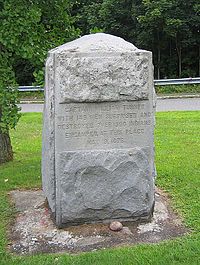| Battle of Turner's Falls | |||||||
|---|---|---|---|---|---|---|---|
| Part of King Philip's War | |||||||
 Marker commemorating the battle | |||||||
| |||||||
| Belligerents | |||||||
| Algonquian tribes, principally Nipmuc |
| ||||||
| Commanders and leaders | |||||||
| William Turner † | |||||||
| Strength | |||||||
| 60-70 warriors | 150 | ||||||
| Casualties and losses | |||||||
| 100-200,mainly women, children, and elderly | 39 killed or captured | ||||||
The Battle of Turner's Falls or Battle of Grand Falls; also known as the Peskeompscut-Wissantinnewag Massacre, was a battle and massacre occurring on May 19, 1676, in the context of King Philip's War in what is present-day Gill and Greenfield, across from Turners Falls on the Connecticut River. The incident marked a turning point in the war, and in the colonization of Native lands by British settlers. The war led to the expulsion of most Native Americans in the Connecticut River Valley.[1]
A largely untrained, inexperienced militia force of 150-160 engaged in an initial massacre early in the morning around dawn, taking advantage of the native practice of the warriors sleeping in a separate camp during wartime about half a mile away, and began looting of the Peskeompskut camp, killing between 100 and 200 people, mostly women and children. Conducting a fighting withdrawal after the counterattack through ambushes set by the Algonquian tribe's outnumbered warriors, resulting in the deaths of 38 militiamen (including the commander, William Turner) and the wounding of an unknown number.[2] The massacre has been described as genocide.[3][4][5] The site of the incident has in recent years been memorialized by the NRHP's establishment as the Riverside Archeological District at the approximate site of the battle.[6]
- ^ Chaubunagungamaug Nipmuck Historic Preservation Office and Associates for the Battle of Great Falls/ Wissatinnewag-Peskeompskut (October 2015). "Remembering & Reconnecting: Nipmucs and the Massacre at Great Falls" (PDF). Town of Montague, Massachusetts. p. 15. Archived (PDF) from the original on 13 August 2022. Retrieved 21 August 2022.
- ^ Cite error: The named reference
ref8was invoked but never defined (see the help page). - ^ Fellman, Noah; Bissonnette, Ashley; Naumec, David; McBride, Dr. Kevin (April 2016). "Battle of Great Falls / Wissatinnewag-Peskeompskut" (PDF). Town of Montague, Massachusetts. National Park Service American Battlefield Protection Program, Department of the Interior & The Mashantucket Pequot Museum & Research Center. p. 321. Archived (PDF) from the original on 3 March 2022. Retrieved 21 August 2022.
- ^ Demers, Phil (27 September 2016). "Turners Falls dig into bloody history of American Indian massacre helping spur move to change high school mascot". MassLive. Archived from the original on 21 August 2022. Retrieved 21 August 2022.
- ^ Demers, Phil (27 September 2016). "Turners Falls dig into bloody history of American Indian massacre helping spur move to change high school mascot". MassLive. Archived from the original on 21 August 2022. Retrieved 21 August 2022.
{{cite web}}: CS1 maint: bot: original URL status unknown (link) - ^ Matthews, Janet Snyder. "Determination of Eligibility Notification" (PDF). NPGallery. U.S. National Park Service, Keeper of the National Register. Retrieved 21 August 2022.